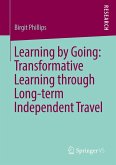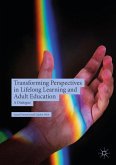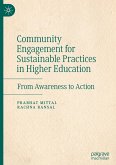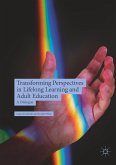Sustainability Learning for Action and Community Engagement
Herausgegeben:Wyman, Sarah Mead; Korenblat, Joshua
Sustainability Learning for Action and Community Engagement
Herausgegeben:Wyman, Sarah Mead; Korenblat, Joshua
- Gebundenes Buch
- Merkliste
- Auf die Merkliste
- Bewerten Bewerten
- Teilen
- Produkt teilen
- Produkterinnerung
- Produkterinnerung
This open access volume is a call to action and a toolbox for educators, administrators, community engagement specialists, and workforce developers who want to make their course content, institutional commitments, and outreach projects relevant to twenty-first century learners. The book demonstrates the impact a higher education institution, its faculty, and community partners can have through education and action for sustainability. By being a sustainability educator and doing sustainability work, individuals can create living and learning labs that make such interdisciplinary activity…mehr
Andere Kunden interessierten sich auch für
![Conceptualizing Environmental Citizenship for 21st Century Education Conceptualizing Environmental Citizenship for 21st Century Education]() Conceptualizing Environmental Citizenship for 21st Century Education38,99 €
Conceptualizing Environmental Citizenship for 21st Century Education38,99 €![Learning by Going: Transformative Learning through Long-term Independent Travel Learning by Going: Transformative Learning through Long-term Independent Travel]() Birgit PhillipsLearning by Going: Transformative Learning through Long-term Independent Travel38,99 €
Birgit PhillipsLearning by Going: Transformative Learning through Long-term Independent Travel38,99 €![Online Learning, Open Education, and Equity in a Post-Pandemic World Online Learning, Open Education, and Equity in a Post-Pandemic World]() Online Learning, Open Education, and Equity in a Post-Pandemic World121,99 €
Online Learning, Open Education, and Equity in a Post-Pandemic World121,99 €![Transforming Perspectives in Lifelong Learning and Adult Education Transforming Perspectives in Lifelong Learning and Adult Education]() Laura FormentiTransforming Perspectives in Lifelong Learning and Adult Education106,99 €
Laura FormentiTransforming Perspectives in Lifelong Learning and Adult Education106,99 €![Community Engagement for Sustainable Practices in Higher Education Community Engagement for Sustainable Practices in Higher Education]() Prabhat MittalCommunity Engagement for Sustainable Practices in Higher Education113,99 €
Prabhat MittalCommunity Engagement for Sustainable Practices in Higher Education113,99 €![Transforming Perspectives in Lifelong Learning and Adult Education Transforming Perspectives in Lifelong Learning and Adult Education]() Laura FormentiTransforming Perspectives in Lifelong Learning and Adult Education106,99 €
Laura FormentiTransforming Perspectives in Lifelong Learning and Adult Education106,99 €![The Sustainability of Higher Education in Sub-Saharan Africa The Sustainability of Higher Education in Sub-Saharan Africa]() The Sustainability of Higher Education in Sub-Saharan Africa129,99 €
The Sustainability of Higher Education in Sub-Saharan Africa129,99 €-
-
-
This open access volume is a call to action and a toolbox for educators, administrators, community engagement specialists, and workforce developers who want to make their course content, institutional commitments, and outreach projects relevant to twenty-first century learners. The book demonstrates the impact a higher education institution, its faculty, and community partners can have through education and action for sustainability. By being a sustainability educator and doing sustainability work, individuals can create living and learning labs that make such interdisciplinary activity integral to campus life and regional engagement. This book answers the United Nations call to universities to step up and address the most urgent crises of our time by marshalling the resources, wisdom and energy of youth and communities to promote active listening, creative expression, greater climate stability, social equity, and, by extension, peace.
Produktdetails
- Produktdetails
- Verlag: Springer, Berlin; Primary Source; State University Of
- Artikelnr. des Verlages: 89287322
- Erscheinungstermin: 13. Februar 2026
- Englisch
- Abmessung: 210mm x 148mm
- ISBN-13: 9783032116970
- ISBN-10: 303211697X
- Artikelnr.: 75665511
- Herstellerkennzeichnung
- Springer-Verlag GmbH
- Tiergartenstr. 17
- 69121 Heidelberg
- ProductSafety@springernature.com
- Verlag: Springer, Berlin; Primary Source; State University Of
- Artikelnr. des Verlages: 89287322
- Erscheinungstermin: 13. Februar 2026
- Englisch
- Abmessung: 210mm x 148mm
- ISBN-13: 9783032116970
- ISBN-10: 303211697X
- Artikelnr.: 75665511
- Herstellerkennzeichnung
- Springer-Verlag GmbH
- Tiergartenstr. 17
- 69121 Heidelberg
- ProductSafety@springernature.com
Sarah Mead Wyman is Associate Professor of English at the State University of New York at New Paltz, USA. Joshua Korenblat is Associate Professor of Graphic Design at the State University of New York at New Paltz, USA.
Chapter 1. Introducton.
Chapter 2. What Are We Hoping to Sustain? A Personal Ecology.
Chapter 3. Eddy: A Living and Learning Lab for Co
Creation.
Chapter 4. Peace, Sustainability, and Educators.
Chapter 5. An in the Meantime, In Between Time, Type of Love.
Chapter 6. The Way of the Real Human Being.
Chapter 7. Drawing Matters.
Chapter 8. Sustain Ability to Live With Earth.
Chapter 9. From (Teaching About) Existential Threats to (Teaching) Existential Resilience and Sustainability.
Chapter 10. Teaching the Wild Within and Around Us.
Chapter 11. Environmental Leadership for Those Not in Charge: Pragmatism, Critical Inquiry, and the Workable Good.
Chapter 12. My Place in the World.
Chapter 13. Teaching and Learning for Sustainability.
Chapter 14. Climate Change and Mental Health: Students’ Use of Poetry to Express Ecoanxiety.
Chapter 15. Physics 101: Understanding the Fuel of our Modern Civilization.
Chapter 16. Teaching the UN SDGs in a Child Development Course.
Chapter 17. Weaving Climate Action Solutions throughout the General Chemistry and Other Core STEM Curricula.
Chapter 18. Using the UN SDGs to Teach Strategic Industry Research.
Chapter 19. Incorporating COIL and the UN SDGs for Global Learning for All.
Chapter 20. An Afrocentric World View on Sustainability and Environmental Justice.
Chapter 21. Illustrating the Geographies of Justice.
Chapter 22. Using the University Campus to Teach Environmental Advocacy.
Chapter 23. Practicing Positive Masculinity.
Chapter 24. Psitherism: What Musicians and Artists Bring to the Climate Justice Movement.
Chapter 25. Food Justice as Social Justice.
Chapter 26. Build it and They Will Come.
Chapter 27. Focus Groups for Assessing Student Perspectives on Sustainability Education.
Chapter 28. Growing a Sustainability
Focused Campus and Fostering Faculty Development.
Chapter 29. The Sustainability Course Designation as Key Stakeholder Communication.
Chapter 30. Foundation Art Program Branches Out, Makes Connections, Builds Community, Finds Common Roots.
Chapter 31. Making Global Engagement for Sustainability Accessible to All.
Chapter 32. Wicked Questions and Writing.
Chapter 33. Sustainability Leadership in Universities: Why it Matters.
Chapter 34. Collaborative Creation for the Campus Ecosystem.
Chapter 35. Building Accessible Bridges of Knowledge Through Disability Studies.
Chapter 36. Songbirds and Sustainability.
Chapter 37. Role
Playing Case Study on Wind Farm Acoustics.
Chapter 38. STREAM: Community
Led Engagement for Health, Wellness and Healing.
Chapter 39. Using Hemp and Public Benefit Contracts to Build a Green Economy by Collaborating with Disproportionately Impacted Communities.
Chapter 40. Formative Participatory Communication and Engagement in Mali and Malawi, West Africa.
Chapter 41. Sculpting Sustainable Futures.
Chapter 42. Finding and Working with Wild Clay.
Chapter 43. Sustainably
Focused Engineered Product Design.
Chapter 44. De
Fetishizing Commodities for Sustainable Futures: How Commodity Chain Analyses Expose the Hidden Social and Environmental Costs of Consumption.
Chapter 45. The DIRT Project: Empathy, Experimentation and Belonging.
Chapter 2. What Are We Hoping to Sustain? A Personal Ecology.
Chapter 3. Eddy: A Living and Learning Lab for Co
Creation.
Chapter 4. Peace, Sustainability, and Educators.
Chapter 5. An in the Meantime, In Between Time, Type of Love.
Chapter 6. The Way of the Real Human Being.
Chapter 7. Drawing Matters.
Chapter 8. Sustain Ability to Live With Earth.
Chapter 9. From (Teaching About) Existential Threats to (Teaching) Existential Resilience and Sustainability.
Chapter 10. Teaching the Wild Within and Around Us.
Chapter 11. Environmental Leadership for Those Not in Charge: Pragmatism, Critical Inquiry, and the Workable Good.
Chapter 12. My Place in the World.
Chapter 13. Teaching and Learning for Sustainability.
Chapter 14. Climate Change and Mental Health: Students’ Use of Poetry to Express Ecoanxiety.
Chapter 15. Physics 101: Understanding the Fuel of our Modern Civilization.
Chapter 16. Teaching the UN SDGs in a Child Development Course.
Chapter 17. Weaving Climate Action Solutions throughout the General Chemistry and Other Core STEM Curricula.
Chapter 18. Using the UN SDGs to Teach Strategic Industry Research.
Chapter 19. Incorporating COIL and the UN SDGs for Global Learning for All.
Chapter 20. An Afrocentric World View on Sustainability and Environmental Justice.
Chapter 21. Illustrating the Geographies of Justice.
Chapter 22. Using the University Campus to Teach Environmental Advocacy.
Chapter 23. Practicing Positive Masculinity.
Chapter 24. Psitherism: What Musicians and Artists Bring to the Climate Justice Movement.
Chapter 25. Food Justice as Social Justice.
Chapter 26. Build it and They Will Come.
Chapter 27. Focus Groups for Assessing Student Perspectives on Sustainability Education.
Chapter 28. Growing a Sustainability
Focused Campus and Fostering Faculty Development.
Chapter 29. The Sustainability Course Designation as Key Stakeholder Communication.
Chapter 30. Foundation Art Program Branches Out, Makes Connections, Builds Community, Finds Common Roots.
Chapter 31. Making Global Engagement for Sustainability Accessible to All.
Chapter 32. Wicked Questions and Writing.
Chapter 33. Sustainability Leadership in Universities: Why it Matters.
Chapter 34. Collaborative Creation for the Campus Ecosystem.
Chapter 35. Building Accessible Bridges of Knowledge Through Disability Studies.
Chapter 36. Songbirds and Sustainability.
Chapter 37. Role
Playing Case Study on Wind Farm Acoustics.
Chapter 38. STREAM: Community
Led Engagement for Health, Wellness and Healing.
Chapter 39. Using Hemp and Public Benefit Contracts to Build a Green Economy by Collaborating with Disproportionately Impacted Communities.
Chapter 40. Formative Participatory Communication and Engagement in Mali and Malawi, West Africa.
Chapter 41. Sculpting Sustainable Futures.
Chapter 42. Finding and Working with Wild Clay.
Chapter 43. Sustainably
Focused Engineered Product Design.
Chapter 44. De
Fetishizing Commodities for Sustainable Futures: How Commodity Chain Analyses Expose the Hidden Social and Environmental Costs of Consumption.
Chapter 45. The DIRT Project: Empathy, Experimentation and Belonging.
Chapter 1. Introducton.
Chapter 2. What Are We Hoping to Sustain? A Personal Ecology.
Chapter 3. Eddy: A Living and Learning Lab for Co
Creation.
Chapter 4. Peace, Sustainability, and Educators.
Chapter 5. An in the Meantime, In Between Time, Type of Love.
Chapter 6. The Way of the Real Human Being.
Chapter 7. Drawing Matters.
Chapter 8. Sustain Ability to Live With Earth.
Chapter 9. From (Teaching About) Existential Threats to (Teaching) Existential Resilience and Sustainability.
Chapter 10. Teaching the Wild Within and Around Us.
Chapter 11. Environmental Leadership for Those Not in Charge: Pragmatism, Critical Inquiry, and the Workable Good.
Chapter 12. My Place in the World.
Chapter 13. Teaching and Learning for Sustainability.
Chapter 14. Climate Change and Mental Health: Students’ Use of Poetry to Express Ecoanxiety.
Chapter 15. Physics 101: Understanding the Fuel of our Modern Civilization.
Chapter 16. Teaching the UN SDGs in a Child Development Course.
Chapter 17. Weaving Climate Action Solutions throughout the General Chemistry and Other Core STEM Curricula.
Chapter 18. Using the UN SDGs to Teach Strategic Industry Research.
Chapter 19. Incorporating COIL and the UN SDGs for Global Learning for All.
Chapter 20. An Afrocentric World View on Sustainability and Environmental Justice.
Chapter 21. Illustrating the Geographies of Justice.
Chapter 22. Using the University Campus to Teach Environmental Advocacy.
Chapter 23. Practicing Positive Masculinity.
Chapter 24. Psitherism: What Musicians and Artists Bring to the Climate Justice Movement.
Chapter 25. Food Justice as Social Justice.
Chapter 26. Build it and They Will Come.
Chapter 27. Focus Groups for Assessing Student Perspectives on Sustainability Education.
Chapter 28. Growing a Sustainability
Focused Campus and Fostering Faculty Development.
Chapter 29. The Sustainability Course Designation as Key Stakeholder Communication.
Chapter 30. Foundation Art Program Branches Out, Makes Connections, Builds Community, Finds Common Roots.
Chapter 31. Making Global Engagement for Sustainability Accessible to All.
Chapter 32. Wicked Questions and Writing.
Chapter 33. Sustainability Leadership in Universities: Why it Matters.
Chapter 34. Collaborative Creation for the Campus Ecosystem.
Chapter 35. Building Accessible Bridges of Knowledge Through Disability Studies.
Chapter 36. Songbirds and Sustainability.
Chapter 37. Role
Playing Case Study on Wind Farm Acoustics.
Chapter 38. STREAM: Community
Led Engagement for Health, Wellness and Healing.
Chapter 39. Using Hemp and Public Benefit Contracts to Build a Green Economy by Collaborating with Disproportionately Impacted Communities.
Chapter 40. Formative Participatory Communication and Engagement in Mali and Malawi, West Africa.
Chapter 41. Sculpting Sustainable Futures.
Chapter 42. Finding and Working with Wild Clay.
Chapter 43. Sustainably
Focused Engineered Product Design.
Chapter 44. De
Fetishizing Commodities for Sustainable Futures: How Commodity Chain Analyses Expose the Hidden Social and Environmental Costs of Consumption.
Chapter 45. The DIRT Project: Empathy, Experimentation and Belonging.
Chapter 2. What Are We Hoping to Sustain? A Personal Ecology.
Chapter 3. Eddy: A Living and Learning Lab for Co
Creation.
Chapter 4. Peace, Sustainability, and Educators.
Chapter 5. An in the Meantime, In Between Time, Type of Love.
Chapter 6. The Way of the Real Human Being.
Chapter 7. Drawing Matters.
Chapter 8. Sustain Ability to Live With Earth.
Chapter 9. From (Teaching About) Existential Threats to (Teaching) Existential Resilience and Sustainability.
Chapter 10. Teaching the Wild Within and Around Us.
Chapter 11. Environmental Leadership for Those Not in Charge: Pragmatism, Critical Inquiry, and the Workable Good.
Chapter 12. My Place in the World.
Chapter 13. Teaching and Learning for Sustainability.
Chapter 14. Climate Change and Mental Health: Students’ Use of Poetry to Express Ecoanxiety.
Chapter 15. Physics 101: Understanding the Fuel of our Modern Civilization.
Chapter 16. Teaching the UN SDGs in a Child Development Course.
Chapter 17. Weaving Climate Action Solutions throughout the General Chemistry and Other Core STEM Curricula.
Chapter 18. Using the UN SDGs to Teach Strategic Industry Research.
Chapter 19. Incorporating COIL and the UN SDGs for Global Learning for All.
Chapter 20. An Afrocentric World View on Sustainability and Environmental Justice.
Chapter 21. Illustrating the Geographies of Justice.
Chapter 22. Using the University Campus to Teach Environmental Advocacy.
Chapter 23. Practicing Positive Masculinity.
Chapter 24. Psitherism: What Musicians and Artists Bring to the Climate Justice Movement.
Chapter 25. Food Justice as Social Justice.
Chapter 26. Build it and They Will Come.
Chapter 27. Focus Groups for Assessing Student Perspectives on Sustainability Education.
Chapter 28. Growing a Sustainability
Focused Campus and Fostering Faculty Development.
Chapter 29. The Sustainability Course Designation as Key Stakeholder Communication.
Chapter 30. Foundation Art Program Branches Out, Makes Connections, Builds Community, Finds Common Roots.
Chapter 31. Making Global Engagement for Sustainability Accessible to All.
Chapter 32. Wicked Questions and Writing.
Chapter 33. Sustainability Leadership in Universities: Why it Matters.
Chapter 34. Collaborative Creation for the Campus Ecosystem.
Chapter 35. Building Accessible Bridges of Knowledge Through Disability Studies.
Chapter 36. Songbirds and Sustainability.
Chapter 37. Role
Playing Case Study on Wind Farm Acoustics.
Chapter 38. STREAM: Community
Led Engagement for Health, Wellness and Healing.
Chapter 39. Using Hemp and Public Benefit Contracts to Build a Green Economy by Collaborating with Disproportionately Impacted Communities.
Chapter 40. Formative Participatory Communication and Engagement in Mali and Malawi, West Africa.
Chapter 41. Sculpting Sustainable Futures.
Chapter 42. Finding and Working with Wild Clay.
Chapter 43. Sustainably
Focused Engineered Product Design.
Chapter 44. De
Fetishizing Commodities for Sustainable Futures: How Commodity Chain Analyses Expose the Hidden Social and Environmental Costs of Consumption.
Chapter 45. The DIRT Project: Empathy, Experimentation and Belonging.








